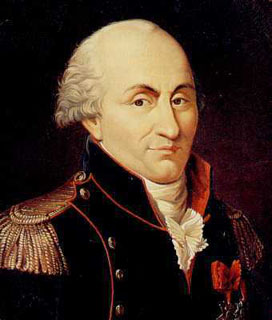 | element14 ranking level 1 in honour of Charles-Augustin de Coulomb the French physicist is best known for creating the definition of electrostatic force of attraction and repulsion, Coulombs Law. |
Coulombs Law
Coulomb's law states that: "The magnitude of the Electrostatics force of interaction between two point charges is directly proportional to the scalar multiplication of the magnitudes of charges and inversely proportional to the square of the distances between them."
This force (F) acting simultaneously on point charges (q1) and (q2), is given by where r is the separation distance and ke is a proportionality constant. A positive force implies it is repulsive, while a negative force implies it is attractive. The proportionality constant ke, called the Coulomb constant (sometimes called the Coulomb force constant), is related to defined properties of space and can be calculated based on knowledge of empirical measurements of the speed of light.
Life/Family
Charles-Augustin de Coulomb was born in Angouleme in south west France to Henry Coulomb and Catherine Bajet. The families from both coulombs parent were well respected in their fields of expertise. His father’s family was highly thought of in the legal profession and his mother’s family were also wealthy.
After growing up in Angouleme his family moved to Paris, while in Paris he enrolled at College Mazarin where he received a good classical education.
In his early life he enrolled to the corps of engineers, where he was posted to Martinique in the Caribbean and helped to construct Fort Bourbon
Professional Achievements
1784
- Recherches théoriques et expérimentales sur la force de torsion et sur l'élasticité des fils de metal (Theoretical research and experimentation on torsion and the elasticity of metal wire)
This memoir contained the results of Coulomb's experiments on the torsional force for metal wires. "... the moment of the torque is, for wires of the same metal, proportional to the torsional angle, the fourth power of the diameter and the inverse of the length of the wire..."
1785
- Premier Mémoire sur l’Electricité et le Magnétisme. (First memoir on electricity and magnetism.). Coulomb describes "How to construct and use an electric balance (torsion balance) based on the property of the metal wires of having a reaction torsion force proportional to the torsion angle." Coulomb also experimentally determined the law that explains how "two bodies electrified of the same kind of Electricity exert on each other."
- Deuxieme Mémoire sur l’Electricité et le Magnétisme (Second Memorandum on Electricity and Magnetism ). In this publication, Coulomb carries out the "determination according to which laws both the Magnetic and the Electric fluids act, either by repulsion or by attraction."
- Troisième Mémoire sur l’Electricité et le Magnétisme (Third Memoir on Electricity and Magnetism). "On the quantity of Electricity that an isolated body loses in a certain time period, either by contact with less humid air or in the supports more or less idio-electric."
1786
- Quatrième Mémoire (Fourth Memoir). "Where two principal properties of the electric fluid are demonstrated: first, that this fluid does not expand into any object according to a chemical affinity or by an elective attraction, but that it divides itself between different objects brought into contact; second, that in conducting objects, the fluid, having achieved a state of stability, expands on the surface of the body and does not penetrate into the interior."
1787
- Cinquième Mémoire (Fourth Memoir). "On the manner in which the electric fluid divides itself between conducting objects brought into contact and the distribution of this fluid on the different parts of the surface of this object."
1788
- Sixième Mémoire (Fourth Memoir). "Continuation of research into the distribution of the electric fluid between several conductors. Determination of electric density at different points on the surface of these bodies."
1789
- Septième Mémoire (Seventh Memoir). "On magnetism"


